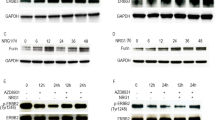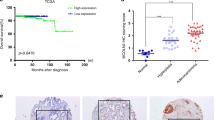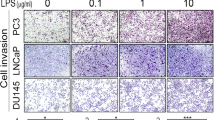Abstract
Lysophosphatidic acid (LPA) is a biolipid that has diverse biological activities implicated in ovarian cancer initiation and progression. Previous studies have shown the critical role of the Rho/Rho-associated kinase (ROCK) pathway in LPA-induced ovarian cancer progression. However, detailed underlying mechanism by which the Rho/ROCK pathway induces ovarian cancer cell invasion is still incompletely understood. In the present study, we observed that the Rho/ROCK pathway is implicated in the production of proteolytic enzymes, leading to LPA-induced ovarian cancer cell invasion. LPA induced matrix metalloproteinase (MMP)-9 expression in CAOV-3 and PA-1 cells and urokinase-type plasminogen activator (uPA) expression in SKOV-3 cells. LPA-induced proteolytic enzyme expression was required for the invasion of ovarian cancer cells expressing corresponding enzymes. Pretreatment of cells with a pharmacological inhibitor of Rho/ROCK (Y-27632) or overexpression of a dominant-negative mutant of Rho (Rho N19) profoundly inhibited LPA-induced proteolytic enzyme expression as well as the invasive potential of ovarian cancer cells. In addition, transfection with dominant-negative Ras (Ras N17) significantly inhibited LPA-induced Rho activation as well as MMP-9 and uPA expression. Consistently, Y-27632 reduced LPA-induced nuclear factor (NF)-κB activation that is critical for proteolytic enzyme expression and cellular invasion. Collectively, we demonstrate a mechanism by which LPA promotes ovarian cancer progression through coordinate activation of a Ras/Rho/ROCK/NF-κB signaling pathway and the proteolytic enzyme secretion, providing novel biomarkers and promising therapeutic targets for ovarian cancer cell progression.
This is a preview of subscription content, access via your institution
Access options
Subscribe to this journal
Receive 50 print issues and online access
$259.00 per year
only $5.18 per issue
Buy this article
- Purchase on Springer Link
- Instant access to full article PDF
Prices may be subject to local taxes which are calculated during checkout







Similar content being viewed by others
References
Bar-Sagi D, Hall A . (2000). Ras and Rho GTPases: a family reunion. Cell 103: 227–238.
Bese T, Barbaros M, Baykara E, Guralp O, Cengiz S, Demirkiran F et al. (2010). Comparison of total plasma lysophosphatidic acid and serum CA-125 as a tumor marker in the diagnosis and follow-up of patients with epithelial ovarian cancer. J Gynecol Oncol 21: 248–254.
Bian D, Su S, Mahanivong C, Cheng RK, Han Q, Pan ZK et al. (2004). Lysophosphatidic Acid stimulates ovarian cancer cell migration via a Ras-MEK kinase 1 pathway. Cancer Res 64: 4209–4217.
Bond M, Fabunmi RP, Baker AH, Newby AC . (1998). Synergistic upregulation of metalloproteinase-9 by growth factors and inflammatory cytokines: an absolute requirement for transcription factor NF-kappa B. FEBS Lett 435: 29–34.
Cammarano MS, Minden A . (2001). Dbl and the Rho GTPases activate NF kappa B by I kappa B kinase (IKK)-dependent and IKK-independent pathways. J Biol Chem 276: 25876–25882.
Chang HR, Huang HP, Kao YL, Chen SL, Wu SW, Hung TW et al. (2010). The suppressive effect of Rho kinase inhibitor, Y-27632, on oncogenic Ras/RhoA induced invasion/migration of human bladder cancer TSGH cells. Chem Biol Interact 183: 172–180.
Dolo V, Adobati E, Canevari S, Picone MA, Vittorelli ML . (1995). Membrane vesicles shed into the extracellular medium by human breast carcinoma cells carry tumor-associated surface antigens. Clin Exp Metastasis 13: 277–286.
Fang X, Schummer M, Mao M, Yu S, Tabassam FH, Swaby R et al. (2002). Lysophosphatidic acid is a bioactive mediator in ovarian cancer. Biochim Biophys Acta 1582: 257–264.
Farina AR, Tacconelli A, Vacca A, Maroder M, Gulino A, Mackay AR . (1999). Transcriptional up-regulation of matrix metalloproteinase-9 expression during spontaneous epithelial to neuroblast phenotype conversion by SK-N-SH neuroblastoma cells, involved in enhanced invasivity, depends upon GT-box and nuclear factor kappaB elements. Cell Growth Differ 10: 353–367.
Fishman DA, Bafetti LM, Banionis S, Kearns AS, Chilukuri K, Stack MS . (1997). Production of extracellular matrix-degrading proteinases by primary cultures of human epithelial ovarian carcinoma cells. Cancer 80: 1457–1463.
Fishman DA, Liu Y, Ellerbroek SM, Stack MS . (2001). Lysophosphatidic acid promotes matrix metalloproteinase (MMP) activation and MMP-dependent invasion in ovarian cancer cells. Cancer Res 61: 3194–3199.
Gardner MJ, Jones LM, Catterall JB, Turner GA . (1995). Expression of cell adhesion molecules on ovarian tumour cell lines and mesothelial cells, in relation to ovarian cancer metastasis. Cancer Lett 91: 229–234.
Gnad R, Kaina B, Fritz G . (2001). Rho GTPases are involved in the regulation of NF-kappaB by genotoxic stress. Exp Cell Res 264: 244–249.
Graves LE, Ariztia EV, Navari JR, Matzel HJ, Stack MS, Fishman DA . (2004). Proinvasive properties of ovarian cancer ascites-derived membrane vesicles. Cancer Res 64: 7045–7049.
Hansen SK, Nerlov C, Zabel U, Verde P, Johnsen M, Baeuerle PA et al. (1992). A novel complex between the p65 subunit of NF-kappa B and c-Rel binds to a DNA element involved in the phorbol ester induction of the human urokinase gene. EMBO J 11: 205–213.
Hodge JC, Bub J, Kaul S, Kajdacsy-Balla A, Lindholm PF . (2003). Requirement of RhoA activity for increased nuclear factor kappaB activity and PC-3 human prostate cancer cell invasion. Cancer Res 63: 1359–1364.
Horiuchi A, Kikuchi N, Osada R, Wang C, Hayashi A, Nikaido T et al. (2008). Overexpression of RhoA enhances peritoneal dissemination: RhoA suppression with lovastatin may be useful for ovarian cancer. Cancer Sci 99: 2532–2539.
Imamura F, Mukai M, Ayaki M, Akedo H . (2000). Y-27632, an inhibitor of rho-associated protein kinase, suppresses tumor cell invasion via regulation of focal adhesion and focal adhesion kinase. Jpn J Cancer Res 91: 811–816.
Kobayashi H, Ohi H, Sugimura M, Shinohara H, Fujii T, Terao T . (1992). Inhibition of in vitro ovarian cancer cell invasion by modulation of urokinase-type plasminogen activator and cathepsin B. Cancer Res 52: 3610–3614.
Kohn EC, Mills GB, Liotta L . (2003). Promising directions for the diagnosis and management of gynecological cancers. Int J Gynaecol Obstet 83 (Suppl 1): 203–209.
Lee J, Park SY, Lee EK, Park CG, Chung HC, Rha SY et al. (2006). Activation of hypoxia-inducible factor-1alpha is necessary for lysophosphatidic acid-induced vascular endothelial growth factor expression. Clin Cancer Res 12: 6351–6358.
Li H, Ye X, Mahanivong C, Bian D, Chun J, Huang S . (2005). Signaling mechanisms responsible for lysophosphatidic acid-induced urokinase plasminogen activator expression in ovarian cancer cells. J Biol Chem 280: 10564–10571.
Mills GB, Fang X, Lu Y, Hasegawa Y, Eder A, Tanyi J et al. (2003). Specific keynote: molecular therapeutics in ovarian cancer. Gynecol Oncol 88: S88–S92; discussion S93-86.
Mills GB, May C, Hill M, Campbell S, Shaw P, Marks A . (1990). Ascitic fluid from human ovarian cancer patients contains growth factors necessary for intraperitoneal growth of human ovarian adenocarcinoma cells. J Clin Invest 86: 851–855.
Mills GB, Moolenaar WH . (2003). The emerging role of lysophosphatidic acid in cancer. Nat Rev Cancer 3: 582–591.
Moser TL, Young TN, Rodriguez GC, Pizzo SV, Bast Jr RC, Stack MS . (1994). Secretion of extracellular matrix-degrading proteinases is increased in epithelial ovarian carcinoma. Int J Cancer 56: 552–559.
Mukai M, Iwasaki T, Tatsuta M, Togawa A, Nakamura H, Murakami-Murofushi K et al. (2003). Cyclic phosphatidic acid inhibits RhoA-mediated autophosphorylation of FAK at Tyr-397 and subsequent tumor-cell invasion. Int J Oncol 22: 1247–1256.
Novak U, Cocks BG, Hamilton JA . (1991). A labile repressor acts through the NFkB-like binding sites of the human urokinase gene. Nucleic Acids Res 19: 3389–3393.
Park SY, Jeong KJ, Panupinthu N, Yu S, Lee J, Han JW et al. (2011a). Lysophosphatidic acid augments human hepatocellular carcinoma cell invasion through LPA1 receptor and MMP-9 expression. Oncogene 30: 1351–1359.
Park SY, Kang JH, Jeong KJ, Lee J, Han JW, Choi WS et al. (2011b). Norepinephrine induces VEGF expression and angiogenesis by a hypoxia-inducible factor-1alpha protein-dependent mechanism. Int J Cancer 128: 2306–2316.
Perona R, Montaner S, Saniger L, Sanchez-Perez I, Bravo R, Lacal JC . (1997). Activation of the nuclear factor-kappaB by Rho, CDC42, and Rac-1 proteins. Genes Dev 11: 463–475.
Pustilnik TB, Estrella V, Wiener JR, Mao M, Eder A, Watt MA et al. (1999). Lysophosphatidic acid induces urokinase secretion by ovarian cancer cells. Clin Cancer Res 5: 3704–3710.
Sawada K, Morishige K, Tahara M, Ikebuchi Y, Kawagishi R, Tasaka K et al. (2002). Lysophosphatidic acid induces focal adhesion assembly through Rho/Rho-associated kinase pathway in human ovarian cancer cells. Gynecol Oncol 87: 252–259.
Sedlakova I, Vavrova J, Tosner J, Hanousek L . (2011). Lysophosphatidic acid (LPA)-a perspective marker in ovarian cancer. Tumour Biol 32: 311–316.
Seo JH, Jeong KJ, Oh WJ, Sul HJ, Sohn JS, Kim YK et al. (2010). Lysophosphatidic acid induces STAT3 phosphorylation and ovarian cancer cell motility: their inhibition by curcumin. Cancer Lett 288: 50–56.
Symowicz J, Adley BP, Woo MM, Auersperg N, Hudson LG, Stack MS . (2005). Cyclooxygenase-2 functions as a downstream mediator of lysophosphatidic acid to promote aggressive behavior in ovarian carcinoma cells. Cancer Res 65: 2234–2242.
Vega FM, Ridley AJ . (2008). Rho GTPases in cancer cell biology. FEBS Lett 582: 2093–2101.
Woo JH, Lim JH, Kim YH, Suh SI, Min DS, Chang JS et al. (2004). Resveratrol inhibits phorbol myristate acetate-induced matrix metalloproteinase-9 expression by inhibiting JNK and PKC delta signal transduction. Oncogene 23: 1845–1853.
Xu Y, Fang XJ, Casey G, Mills GB . (1995). Lysophospholipids activate ovarian and breast cancer cells. Biochem J 309 (Part 3): 933–940.
Xu Y, Shen Z, Wiper DW, Wu M, Morton RE, Elson P et al. (1998). Lysophosphatidic acid as a potential biomarker for ovarian and other gynecologic cancers. JAMA 280: 719–723.
Young TN, Rodriguez GC, Rinehart AR, Bast Jr RC, Pizzo SV, Stack MS . (1996). Characterization of gelatinases linked to extracellular matrix invasion in ovarian adenocarcinoma: purification of matrix metalloproteinase 2. Gynecol Oncol 62: 89–99.
Acknowledgements
Basic Science Research Program through the National Research Foundation of Korea funded by the Ministry of Education, Science and Technology (2011-0025912 and 2011-0015761, HYL; 2011-0028284, JWH). We thank Professor Gordon B Mills for a plasmid-containing uPA promoter and invaluable discussion, Professor Aree Moon for Ras V12 and Ras N17 and Professor Taeg Kyu Kwon for MMP-9 promoters.
Author information
Authors and Affiliations
Corresponding author
Ethics declarations
Competing interests
The authors declare no conflict of interest.
Additional information
Supplementary Information accompanies the paper on the Oncogene website
Rights and permissions
About this article
Cite this article
Jeong, K., Park, S., Cho, K. et al. The Rho/ROCK pathway for lysophosphatidic acid-induced proteolytic enzyme expression and ovarian cancer cell invasion. Oncogene 31, 4279–4289 (2012). https://doi.org/10.1038/onc.2011.595
Received:
Revised:
Accepted:
Published:
Issue Date:
DOI: https://doi.org/10.1038/onc.2011.595
Keywords
This article is cited by
-
Lysophosphatidic acid exerts protective effects on HEI-OC1 cells against cytotoxicity of cisplatin by decreasing apoptosis, excessive autophagy, and accumulation of ROS
Cell Death Discovery (2023)
-
The role of the microbiome in ovarian cancer: mechanistic insights into oncobiosis and to bacterial metabolite signaling
Molecular Medicine (2021)
-
Multicellular contractility contributes to the emergence of mesothelioma nodules
Scientific Reports (2020)
-
Blockade of ROCK inhibits migration of human primary keratinocytes and malignant epithelial skin cells by regulating actomyosin contractility
Scientific Reports (2019)
-
Acidosis and proteolysis in the tumor microenvironment
Cancer and Metastasis Reviews (2019)



